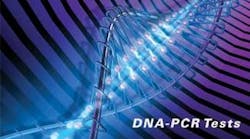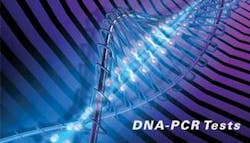What hygienists need to know about these salivary tests
by Lisa C. Wadsworth, RDH
DNA–PCR (polymerase chain reaction) tests, developed by an American biochemist in 1983, are not new to the medical community, and are making impressive inroads into the field of dentistry. For the first time, dental professionals have the opportunity to use science down to the DNA level to significantly improve the quality of care we provide for our patients. The overall impact will be profound.
Salivary DNA–PCR test results will provide us with a comprehensive view of our patients' periodontal status and the particular bacteria behind each case. Information such as the exact type and concentration of pathogenic periodontal bacteria affecting each case will be summarized, along with specific recommendations for successful treatment planning.
From this point forward, hard science will help us guide our patients to an absolutely evidence–driven model. The data has the power to reshape our treatment planning by eliminating any guesswork about the type of periodontal pathogens attacking our patients. What an invaluable asset to the hygiene community!
Many biological tests are available in our profession for determining the presence of disease–causing pathogens. Some use indirect immunofluorescence assays, or anaerobic cultures, accompanied by tests that measure biochemical reactions. Although helpful, these tests may require sophisticated and expensive equipment, time–sensitive techniques, and highly specialized laboratory environments to obtain results. These parameters make it difficult to implement such tests into a dental visit.
DNA–PCR testing
Two "state–of–the–science" tests recently launched by OralDNA Labs™ (www.OralDNAtraining.com) require nothing more than collecting a saliva sample from the patient. The saliva collection process can be quickly and easily performed chairside.
To collect a saliva sample, patients must swish briefly with sterile saline and expectorate into a vial that will be shipped to the laboratory. The samples are shipped to the OralDNA laboratory, where they are thoroughly analyzed. A comprehensive report is available for us to use within four to five business days.
Determining specific pathogenic burden
The first test, MyPerioPathSM, identifies the type and quantity of 13 primary bacteria associated with periodontal disease. Knowing the type of bacteria is important. As clinicians, we are familiar with the term "red complex" bacteria, but there are two more categories: "orange complex" and "green complex" species.
The orange and red complexes are typically present in moderate and severe periodontal disease, while the green complex is somewhat less virulent, yet still plays an important role in assessing the patient's overall perio–pathogenic burden.
Knowing the quantity of each category is important because the presence of these bacteria in the mouth does not necessarily mean that there is active disease. All of us have potentially disease–causing bacteria in our mouths, even those of us working in dentistry!
So why does the information matter? When the levels of good and bad bacteria are in balance (homeostasis), disease can be kept in check and our patients will remain stable. However, when the quantity of pathogenic bacteria rises above a specific number, called the disease threshold, infection may already be present, or the disease process may be just beyond the horizon.
What tips the scale?
We do know that periodontal pathogens are opportunistic and may strike quickly when a patient's overall health is compromised. Situations that place our patients at risk include smoking, emotional or physical stress, hormonal shifts, acute infections, and chronic medical conditions such as diabetes.1,2
The test is designed to be administered more than once. In fact, retesting is essential to determine whether or not treatment recommendations are working, or to secure a new baseline after a medical event. The first test results should be considered the patient's baseline, to which subsequent test results can be compared. Can you think of a better way to ensure a stable result for our patients?
The second test available is MyPerioIDsm PST®, which begins with the same simple saliva collection system. A "once–in–a–lifetime" test, its purpose is to determine if a patient is genetically predisposed to periodontal disease. This genetic makeup will not change during the course of one's life. The test looks for specific genetic variations in the patient's DNA associated with interleukin–1 (IL–1) production. The IL–1 polymorphism is found in approximately 30% of the population.3
People who possess the IL–1 polymorphism are considered to be at greater risk for developing severe periodontal disease than patients who are IL–1 negative.3 I find this DNA evidence very exciting; we will need to develop new communication skills to fully assimilate the information we will need to educate patients. For me, this test provides a building block for all patient therapy.
How a DNA–PCR test works
A person's saliva contains two kinds of DNA: human DNA, which comes from white blood cells and epithelial cells that are continually being shed from the oral mucosa and salivary glands, coupled with the DNA of all the bacteria in the mouth. Saliva actually contains more DNA than blood, as it contains millions of bacteria, each with its own unique DNA profile. Salivary DNA can be analyzed whether the bacteria in it are alive or dead. This is an advantage because there is no need for special handling or immediate sampling analysis, as is required for tests that use living bacteria.
In molecular biology, both kinds of DNA can be extracted and analyzed through a laboratory process called polymerase chain reaction, or PCR. The PCR process essentially duplicates a particular piece of DNA in a test tube. Once the saliva samples are received at the laboratory, tiny drops of the sample are syringed into reaction tubes to which specific enzymes, primers, and buffers are added.
The test tubes are then placed into a device called a thermocycler. When the DNA in the sample is heated to 90 degrees fahrenheit, its strands separate and mix with the added components. If the components find their complementary sequences in the DNA, they bind to them. This creates a copy of that DNA strand.
The process is repeated for about 90 minutes, at which time over 1 billion DNA strands are produced. These DNA sequences are compared to the DNA of 13 kinds of perio–pathogenic bacteria, and they are also quantified. The results provide a comprehensive, precise picture of the bacterial profile in a person's mouth — as it relates to the bacteria we are interested in. With the lab results report, we can create targeted and optimized treatment plans for patients because we know specifically what bacteria we're up against.
Enhanced patient communication and compliance
Each year, we visit our physicians and blood work is drawn and analyzed to determine our overall health. The new DNA tests available to the dental community will enable us to monitor our patients with the same consistency and assurance of a truly scientific diagnosis. The guesswork is finally gone!
We have all encountered patients who either deny or ignore the fact that they have periodontal disease, even though this attitude is understandable because they can't see it. This is the familiar "bleeding gum" syndrome: "I've always had some bleeding," or the old "I don't have any pain." This is due to the fact that the disease generates few or no painful symptoms until it is almost too late.
The reports generated by these tests will show in graphic detail the kind and quantity of bacteria that are above the disease–causing threshold. For the first time, patients will be afforded a visual representation of the disease–causing "germs" in their mouths.
This graphic display will be a compelling motivator for patients to comply with the prescribed treatment protocol. Continued data confirmation of their treatment progress could be just the validation patients need to stick with their prescribed treatment plans and homecare regimens.
About a year ago, we began suggesting that our patients take copies of their periodontal probings for their physicians to review during their annual physicals. I think it will be fabulous to share with physicians the detailed results of the two new tests.
For me, DNA–PCR testing represents a diagnostic platform backed by indisputable science. Never before have we had such a scientific foundation, which will elevate our level of confidence in the treatment plans we present.
We will now be able to act with complete focus and clarity, knowing that we are shaping our patients' treatment plans according to their unique DNA. To me, this is remarkable, and exactly what we've been waiting for. I've enjoyed practicing hygiene for 25 years and have never felt as secure as I do now, knowing that every patient can be individually diagnosed and treatment–planned.
It is wonderful that we now have a scientific based method to support the design of a patients' long–term treatment care plan. Finally, we have the technology to enter into a dialogue with our patients to develop lifelong strategies for maintaining oral health while helping to support the stability of their overall systemic health. Patient management programs based on hard DNA evidence — how much better can it get!
References
- Kim J, Amar S. Periodontal disease and systemic conditions: a bidirectional relationship. Odontology 2006;94(1):10–21.
- Kantarci A, Van Dyke TE. Resolution of inflammation in periodontitis. J Periodontal 2005;76(11 Suppl):2168–2174.
- Lang NP, Tonetti MS, Suter J, et al. Effect of interleukin–1 gene polymorphisms on gingival inflammation assessed by bleeding on probing in a periodontal maintenance population. J Periodontal Res 2000;35:102–107.
About the Author
Lisa C. Wadsworth is a lecturer and president of Lisa C. Wadsworth Inc., a dental hygiene consulting company focused on the integration of advanced hygiene therapy, implant dentistry, and the improvement of communication skills that lead to the acceptance of highly technical treatment plans. She can be reached at 215–862– 5912 or [email protected].







